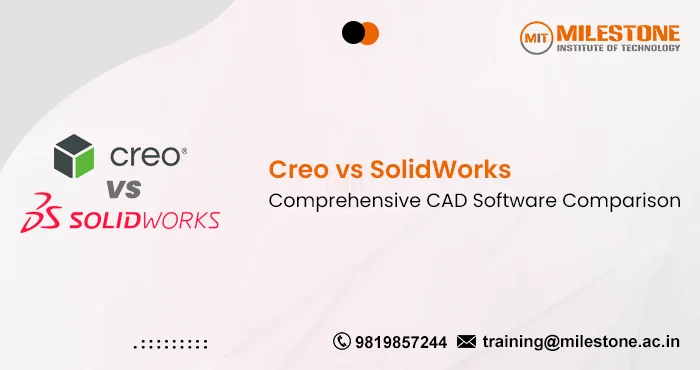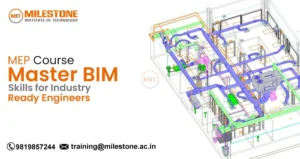
Creo and SolidWorks are two main software applications that engineers and designers often use in the Computer-Aided Design (CAD) world. While both provide great design, engineering and simulation tools they serve different needs and types of people. In this blog, we will understand a detailed comparison between Creo Vs Solidworks, their features and differences and many more.
What is Creo?
Creo is a full-featured CAD software system only for 3D product design and engineering developed by PTC. Originally called Pro/ENGINEER, Creo has grown to offer a wide range of components needed for product development including parametric and direct modeling. Many industries needing high accuracy and complex modeling know it for its powerful features and flexibility.
Features of Creo
- Parametric and Direct Modeling: Creo allows for both parametric and direct modeling, so that designs can be created or edited any way you want. This two-fold approach is able to manage complex designs and iterative changes more effectively.
- Advanced Assembly Capabilities: Creo has specialized tools for both Assembly design, visualization & analysis that are helpful in managing large assemblies. It offers incredible performance even for complex assemblies containing thousands of components.
- Generative Design: The Creo Generative design tool enables you to generate optimized designs using the performance criteria. This will definitely help in finding unique design solutions that we may not have thought about before.
- Integrated Simulation: Creo also includes integrated simulation for performing analysis of solids, fluids and motion within the design environment. This process helps them ensure that they validate their designs even more smoothly.
- Augmented Reality (AR): Creo, offers AR abilities where one can see a design in real-time spaces. This makes the digital model more widely accessible and physical, improving design communication and collaboration.
- Additive Manufacturing: Creo supports additive manufacturing (3D printing) with tools for model preparation and designing those models to take the best advantage of a range of 3D print technologies.
What is SolidWorks?
SolidWorks is a user-friendly CAD software, developed by Dassault Systèmes and released first in 1995. It is widely used by many engineers and designers for its natural design process and numerous innovative products that work with this engineering tool. It is used to serve a wide range of industries like Mechanical, Aerospace and consumer products.
Features of SolidWorks
- User-Friendly Interface: Many users know SolidWorks for its simple and easy-to-learn interface, which makes designing easier and presents newcomers with a shorter learning curve.
- Robust Parametric Modeling: SolidWorks offers powerful parametric modeling tools, enabling users to create and modify designs based on parameters and relationships. This feature supports design changes and updates efficiently.
- Extensive Libraries and Components: SolidWorks includes extensive libraries of standard components and materials, facilitating faster design and reducing the need for manual component creation.
- Integrated Simulation and Analysis: SolidWorks provides integrated simulation tools for structural, thermal, and fluid flow analysis. The designers designed the simulation tools to be accessible within the CAD environment, streamlining the design validation process.
- Sheet Metal and Weldment Design: SolidWorks has tools for sheet metal and weldment design, simplifying component creation and documentation.
- Product Data Management (PDM): SolidWorks offers PDM solutions to manage design data, streamline workflows, and improve collaboration among team members.
Creo vs SolidWorks: Key Differences
| Feature | Creo | SolidWorks |
| Modeling Approach | Parametric and Direct Modeling | Primarily Parametric Modeling |
| Assembly Management | Advanced capabilities for large assemblies | Effective, but can be slower with very large assemblies |
| Generative Design | Available for optimized design | Not natively available; relies on third-party tools |
| Simulation Integration | Integrated with advanced simulation tools | Integrated simulation tools, but less advanced than Creo |
| Augmented Reality (AR) | Native support for AR | No native AR support; relies on third-party solutions |
| Additive Manufacturing | Supports various 3D printing technologies | Basic support for 3D printing |
| User Interface | More complex; steep learning curve | Intuitive and user-friendly |
| Libraries and Components | Extensive, but more focused on customization | Extensive libraries for standard components |
| Product Data Management (PDM) | Separate PDM solution (Windchill) | Integrated PDM with SolidWorks PDM |
Where Can You Learn Creo and SolidWorks?
If you are looking for a place to master Creo or SolidWorks, there are many training centers as well as institutes which provide comprehensive courses for Mechanical engineering software. Milestone Institute of Technology is one of the leading institutes in Mumbai which offers many different courses such as engineering, IT, graphic designing, and many more. Their experienced faculties focus on providing quality skills and training for the students for a successful career journey.
Frequently Asked Questions
Which software is better for complex assembly designs, Creo or SolidWorks?
Creo excels in managing large assemblies better than SolidWorks due to its advanced capabilities and optimization for performance. SolidWorks is effective but may experience performance issues with very large or complex assemblies.
Can Creo and SolidWorks be used for generative design?
Creo includes native generative design tools that allow users to optimize designs based on performance criteria. SolidWorks does not have built-in generative design capabilities and typically relies on third-party software for this functionality.



